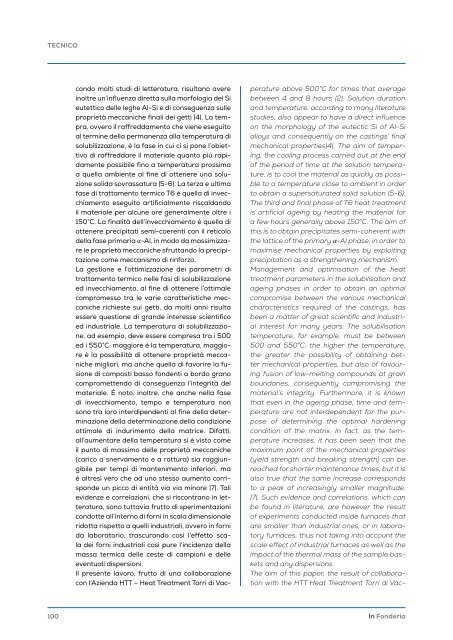In Fonderia 1 2024
Primo numero del 2024 di In Fonderia
Primo numero del 2024 di In Fonderia
Create successful ePaper yourself
Turn your PDF publications into a flip-book with our unique Google optimized e-Paper software.
TECNICO<br />
condo molti studi di letteratura, risultano avere<br />
inoltre un’influenza diretta sulla morfologia del Si<br />
eutettico delle leghe Al-Si e di conseguenza sulle<br />
proprietà meccaniche finali dei getti |4|. La tempra,<br />
ovvero il raffreddamento che viene eseguito<br />
al termine della permanenza alla temperatura di<br />
solubilizzazione, è la fase in cui ci si pone l’obiettivo<br />
di raffreddare il materiale quanto più rapidamente<br />
possibile fino a temperatura prossima<br />
a quella ambiente al fine di ottenere una soluzione<br />
solida sovrassatura |5-6|. La terza e ultima<br />
fase di trattamento termico T6 è quella di invecchiamento<br />
eseguito artificialmente riscaldando<br />
il materiale per alcune ore generalmente oltre i<br />
150°C. La finalità dell’invecchiamento è quella di<br />
ottenere precipitati semi-coerenti con il reticolo<br />
della fase primaria α-Al, in modo da massimizzare<br />
le proprietà meccaniche sfruttando la precipitazione<br />
come meccanismo di rinforzo.<br />
La gestione e l’ottimizzazione dei parametri di<br />
trattamento termico nelle fasi di solubilizzazione<br />
ed invecchiamento, al fine di ottenere l’ottimale<br />
compromesso tra le varie caratteristiche meccaniche<br />
richieste sui getti, da molti anni risulta<br />
essere questione di grande interesse scientifico<br />
ed industriale. La temperatura di solubilizzazione,<br />
ad esempio, deve essere compresa tra i 500<br />
ed i 550°C: maggiore è la temperatura, maggiore<br />
è la possibilità di ottenere proprietà meccaniche<br />
migliori, ma anche quella di favorire la fusione<br />
di composti basso fondenti a bordo grano<br />
compromettendo di conseguenza l’integrità del<br />
materiale. È noto, inoltre, che anche nella fase<br />
di invecchiamento, tempo e temperatura non<br />
sono tra loro interdipendenti al fine della determinazione<br />
della determinazione della condizione<br />
ottimale di indurimento della matrice. Difatti,<br />
all’aumentare della temperatura si è visto come<br />
il punto di massimo delle proprietà meccaniche<br />
(carico a snervamento e a rottura) sia raggiungibile<br />
per tempi di mantenimento inferiori, ma<br />
è altresì vero che ad uno stesso aumento corrisponde<br />
un picco di entità via via minore |7|. Tali<br />
evidenze e correlazioni, che si riscontrano in letteratura,<br />
sono tuttavia frutto di sperimentazioni<br />
condotte all’interno di forni in scala dimensionale<br />
ridotta rispetto a quelli industriali, ovvero in forni<br />
da laboratorio, trascurando così l’effetto scala<br />
dei forni industriali così pure l’incidenza della<br />
massa termica delle ceste di campioni e delle<br />
eventuali dispersioni.<br />
Il presente lavoro, frutto di una collaborazione<br />
con l’Azienda HTT – Heat Treatment Torri di Vacperature<br />
above 500°C for times that average<br />
between 4 and 8 hours |2|. Solution duration<br />
and temperature, according to many literature<br />
studies, also appear to have a direct influence<br />
on the morphology of the eutectic Si of Al-Si<br />
alloys and consequently on the castings’ final<br />
mechanical properties|4|. The aim of tempering,<br />
the cooling process carried out at the end<br />
of the period of time at the solution temperature,<br />
is to cool the material as quickly as possible<br />
to a temperature close to ambient in order<br />
to obtain a supersaturated solid solution |5-6|.<br />
The third and final phase of T6 heat treatment<br />
is artificial ageing by heating the material for<br />
a few hours generally above 150°C. The aim of<br />
this is to obtain precipitates semi-coherent with<br />
the lattice of the primary α-Al phase, in order to<br />
maximise mechanical properties by exploiting<br />
precipitation as a strengthening mechanism.<br />
Management and optimisation of the heat<br />
treatment parameters in the solubilisation and<br />
ageing phases in order to obtain an optimal<br />
compromise between the various mechanical<br />
characteristics required of the castings, has<br />
been a matter of great scientific and industrial<br />
interest for many years. The solubilisation<br />
temperature, for example, must be between<br />
500 and 550°C: the higher the temperature,<br />
the greater the possibility of obtaining better<br />
mechanical properties, but also of favouring<br />
fusion of low-melting compounds at grain<br />
boundaries, consequently compromising the<br />
material’s integrity. Furthermore, it is known<br />
that even in the ageing phase, time and temperature<br />
are not interdependent for the purpose<br />
of determining the optimal hardening<br />
condition of the matrix. <strong>In</strong> fact, as the temperature<br />
increases, it has been seen that the<br />
maximum point of the mechanical properties<br />
(yield strength and breaking strength) can be<br />
reached for shorter maintenance times, but it is<br />
also true that the same increase corresponds<br />
to a peak of increasingly smaller magnitude.<br />
|7|. Such evidence and correlations, which can<br />
be found in literature, are however the result<br />
of experiments conducted inside furnaces that<br />
are smaller than industrial ones, or in laboratory<br />
furnaces, thus not taking into account the<br />
scale effect of industrial furnaces as well as the<br />
impact of the thermal mass of the sample baskets<br />
and any dispersions.<br />
The aim of this paper, the result of collaboration<br />
with the HTT Heat Treatment Torri di Vac-<br />
100<br />
<strong>In</strong> <strong>Fonderia</strong>














